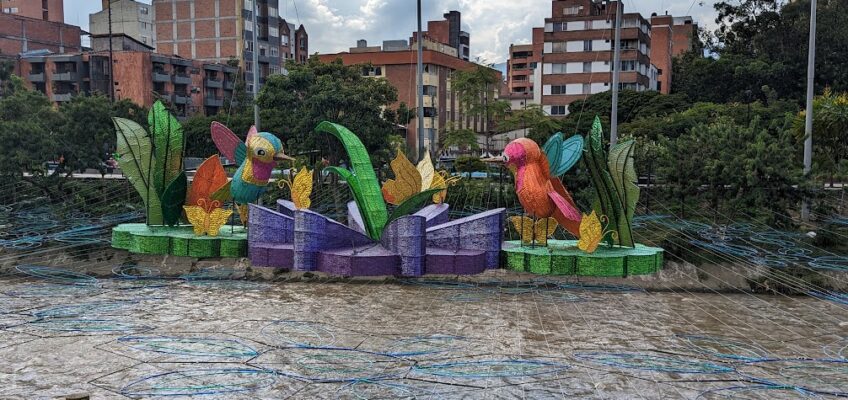I’m not going to write a whole lot about Medellín. It’s actually not a very pretty city. In spite of being surrounded by hills, Medellín doesn’t have an attractive cityscape.
I enjoyed a few aspects of the city anyway, so I’ll focus on those, and leave the rest for you to discover in my photo albums.
Graffiti
There is a lot of graffiti around the city, but it is particularly significant in Comuna 13.
The history of Comuna 13
Up until a few years ago, Comuna 13 was one of the most dangerous places in Medellín, at a time when Medellín was the most dangerous city in the world. But this community has undergone a complete transformation. It is now a center of culture for the city (which has also undergone a transformation).
Comuna 13 started in the 1970s as an illegal settlement. Families displaced by violence in other parts of Antioquia department settled here, on the side of one of the hills on the west side of Medellín, building houses from basic materials, without electricity or running water.
At the height of Medellín’s drug and gang wars in the 1980s and 1990s, Comuna 13 attracted drug traffickers, gangsters, and guerrilla groups like ELN and FARC. The winding streets and haphazard infranstructure in the commune provided places for these groups to hide and conduct activity surreptitiously. Soon various groups began fighting each other for control of the area.
When Alvaro Uribe became President of Colombia in 2002, he launched several military campaigns designed to root out the various paramilitary forces operating in Comuna 13. But these resulted in significant collateral damage, with many innocent people killed or missing. Then in 2006, Medellín mayor Sergio Fajardo Valderrama set about improving living conditions, working with the residents to determine how to improve infrastructure and to integrate Communa 13 with the rest of the city. A new metro station came in 2008, and a network of outdoor escalators was added in 2011.
Comuna 13 today
Graffiti is illegal in Medellín, but in Communa 13, street artists obtain permission to create murals. Every three years, new murals replace old ones. And they are symbolic. Social change, racial justice, and “never forget” the former violence are common themes.
Comuna 13 is not just one neighborhood. It’s a vast area of the city. And it’s a labyrinth of twisting streets, with stairs as well as the escalators. There are tons of souvenir shops, cafés, restaurants, galleries, and of course houses where people live. Our gang was one of many tourist groups snapping photos and gawking at the graffiti and the views of the city.

Johnny, our guide, told us about the significance of the various symbolism in the murals, but I don’t remember any of it. You can see more samples in my photo album (link below).
Walking
I walked a lot. I also rode the Metro. It is clean, convenient, and easy to navigate. In addition to trains, it uses trams and cable-cars.
At one point I needed to transfer from a train line to a tram. I wasn’t sure where to go, so I asked someone. He wasn’t sure either, so he took me over to a transit police officer, who told him where I needed to go. He then proceded to take me down the escalator and show me the entrance to the tram station. On the way he asked me where I am from and complimented me on my Spanish.
Art
I love a good art museum. But I didn’t expect to find one in Medellín.
Turns out I was mistaken. The Museo Antioquia has an extraordinary collection, emphasizing Colombian artists from the last hundred years or so. (I linked to their website, but it’s really pretty bad.) My plan was stroll through the museum for maybe an hour; I ended up spending three.
I made an album of some of my favorite works from their collection. Here are a few to whet your appetite.
Shopping
Our hotel was close to two shopping malls. So I went shopping.
The insole in my shoes wore through. So I bought new insoles. But they wouldn’t stay put in my shoes. So the second night I bought new shoes. They are very comfortable.
This morning we came to Guatapé. I’ll blog about it tomorrow.
Here are all my photos from Medellín (except the ones from the Museo Antioquia). I did some other things, so the photos are definitely worth checking out.














Leave a Reply